Automaten Hoffmann Profi 5913 Assembly Manual
- Typ
- Assembly Manual

0218212 ©2018 Automaten Homann
Automaten Hoffmann
Turnierkicker „Profi“
Kicker
Aufbauanleitung/Assembly manual: Art. 5913
Automaten Homann GmbH · Im Teelbruch 86–90 · 45219 Essen
Tel. 02054 125770 · Fax: 02054 83094 · info@automaten-homann.de · www.automaten-homann.de
Automaten Hoffmann Soccer Table „Profi“

KickerAufbauanleitung/Assembly manual: Art. 5913
2
D GB
Herzlichen Glückwunsch! Wir ho en Sie werden
viel Spaß mit Ihrem neuen Kickertisch haben!
Congratulations! We hope you will have many
hours to use your new soccer table and enjoy the
pleasure it brings to you !
Please keep your instructions!
• Sie brauchen Ihre Seriennummer wenn Sie uns
kontaktieren.
• Bitte lesen Sie sich vor der Montage die Anlei-
tung sorgfältig durch und machen sich mit den
Bauteilen vertraut
• Bitte überprüfen Sie vor Beginn der Montage ob
alle Teile vollständig sind.
Kontakt lnformation:
Automaten Ho mann GmbH
Im Teelbruch 77
45219 Essen-Kettwig
Telefon: 02054 16738
www.automaten-ho mann.de
Warnung!
• Bitte bewahren Sie Schmiermittel und Bälle
außerhalb der Reichweite von Kindern auf
• Sprühen Sie das Schmiermittel nicht auf Per-
sonen oder Tiere Lassen Sie Ihre Kinder nicht
unbeaufsichitgt mit dem Kickertisch spielen
• Bitte seien Sie im Umgang mit den Kicker-
stangen vorsichitg um Verletzungen zu ver-
meiden
• Bitte lesen Sie die Au auanleitung sorgfältig
um Verletzungen oder Beschädigungen zu ver-
meiden
Folgende Werkzeuge werden zur Montage benötigt:
• Schlitzschraubenzieher, Kreuzschlitzschrauben-
zieher, Akkuschrauber, nicht enthalten
• Werkzeug für Spannsti (# 21), Innensechs-
kant-Schlüssel (#14) (enthalten)
Bitte halten Sie sich an die Au auanleitung
• Your Model number is needed when you contact
us.
• Please read through this instruction book to
familiarize yourself with all the parts and
assembly steps.
• Please nd the attached tables for all the parts‘
name, speci cation and quantity.
Contact Information:
Automaten Ho mann GmbH
Im Teelbruch 77
45219 Essen-Kettwig
Telefon: 02054 16738
www.automaten-ho mann.de
Warning!
• Please keep the balls,lubricant and other parts
out of children’s reach.
• Don‘t spray the lubricant to any person or
animal.
• This is not a child’s toy. Adult supervision is
required for children playing this game.
• please take care to avoid injuring any !hing or
person when you push and pull the player rods .
• Please read instructions carefully. Proper use of
this set can avoid damage or injury .
Tools required for assembly:
• Phillips and Slotted Head Screwdrivers , Power
Driver or Hammar(not included)
• Roll Pin Punch (#21), Allen Key (#14) (included)
STOP STOP

KickerAufbauanleitung/Assembly manual: Art. 5913
3
Teileliste / Parts list:
1 2 3 4 5
6 7 8 9 10
11 12 13 14 15
16 17 18 19 20
21 22 23 24 25
26 27 28
29 30 31
Korpus
Main frame
Bein
Leg
2-Spieler Stange
2 player rod
3-Spieler Stange
3 player rod
5-Spieler Stange
5 player rod
Heimmannscha
Home players
Gastmannscha
Visitor players
ø0,4x2,86 cm Schraube
für Kicker gur & Stellring
X1-1/8" screw
Mutter ø 0,4 cm
für Kicker gur & Stellring
Lock nut
ø1,6 x 3,6 cm Scheibe
5/8" x 36 mm washer
Stangenendkappe
Rod end cap
Stellring
Stop ring
Gri
Rod handle
Stangenpu er
Bumper
ø0,4 x 1,6 cm Schraube
8 x 5/8" screw
Balleinwurfschale
Ball entry cup
ø1 x 13,3 cm Schraube
für Unterlegscheiben
3/8" x 5-1/4" screw
3/8“ Mutter
für Unterlegscheiben
3/8“ lock nut
ø1,27 x 5,1 cm Scheibe
1/2" x 51 mm washer
ø1 x 2,5 cm Scheibe
3/8" x 25 mm washer
ø 1 cm Unterlegscheibe
3/8" washer
ø0,4 x 5,1 cm Schraube
für Torzählwerke
F4 x 2" screw
Torzählwerke
Scoring system
ø0,5 x 1,5 cm Schraube
für Kickergri e
T5 x 15 mm screw
Ball
Soccer ball
Schraubenschlüssel
Wrench
Höhenversteller
Leg leveller
Abdeckkappe
cover cap
Punktetafel
Score board
Adapter
Adapter
ø0,4 x 1,2 cm Schraube
für Torzählwerke
T4 x 12 mm screw
1
Korpus
30
1x 4x 2x 4x 2x
11x 11x 26x 26x 16x
8x 4x 8x 16x 6x
2x 16x 16x 16x 16x
16x 4x 2x 8x 4x
1x 4x 2x
1x 1x 2x
Optinal bestellbar /
Optional parts:

KickerAufbauanleitung/Assembly manual: Art. 5913
4
Schritt 1
step 1
Schritt 2
step 2

KickerAufbauanleitung/Assembly manual: Art. 5913
5
Schritt 3
step 3
Schritt 4 (mit optionalen Teilen)
step 4 (for optional parts)

KickerAufbauanleitung/Assembly manual: Art. 5913
6
D GBGB
Tischpflege
Tischoberfläche
Decken Sie den Tisch stets ab. Entfernen Sie Staub auf dem
Spielfeld mit einem Handstaubsauger oder einem sauberen, wei-
chen Tuch. Setzen Sie sich nicht auf den Tisch, und benutzen Sie
den Tisch nicht draußen.
Kickerstangen
Reinigen Sie hin und wieder die Kickerstangen mit einem sau-
beren, trockenen Tuch. Vermeiden Sie zu starkes Drehen und
Drücken der Kickerstangen. Wrr empfehlen das Schmienmittel für
Kickerstangen und Kugellager von außen anzuwenden, um zu
vermeiden das etwas davon auf das Spielfeld gelangt.
Beine
Uberprüfen Sie ob die Beinschrauben fest sind. Wenn Sie den
Tisch verschieben wollen, ziehen Sie ihn nicht über den Boden,
sondern heben Sie ihn an.
Table maintenance
Table surface
Keep your table covered. lf there is dust on the play eld or the
aprons, use a vacuum or wipe with a clean, so cloth to remove.
Do not sit on the table and do not use the table outside.
Rods
Occasionally wipe the rods with a clean, so cloth. Never li the
table by the rods. Do not spin or press the rods too agggressively,
as this may cause damage. We recommend the use of lubricant to
wipe the Player Rods and Bearings from the outside of the game so
as not to drip onto the play eld.
Beine
Check that the leg bolts are light. When moving the table, li table
o of its legs and place it down squarely on the legs, do not drag
the table.
D
Spieleraustausch
Lösen Sie die Kickerstange, entfernen Sie den Spannsti (#17),
dann montieren Sie den neuen Spieler samt Spannsti an
der Kickerstange. Siehe Abbildung 1.
Nutzen Sie hierfür das Werkzeug für den Spannsti (#21).
Player maintenance
Take down the Player Rod, knock the Roll Pin (#17) out, then attach
the spare Players and Roll Pin to this Player Rod. See Fig.1.
Use the Roll Pin Punch (#21) provided .
Abb. 1
Figure 1
Spielregeln
1) Um das Spiel zu starten, werfen Sie eine Münze um zu ent-
scheiden welcher Spieler als erstes den Ball hat. Werfen Sie
den Ball in die Balleinwurfschale um das Spiel zu starten.
2) Passen und punkten Sie indem Sie die Kickerstangen ziehen
und schieben. Das Drehen der Kickerstange ist während des
Spiels nicht gestattet. Bei Spielen im Team, dürfen die Team-
mitglieder ihre Position nicht mehr verändern sobald der Ball
im Spiel ist. Dies gilt bis ein Team punktet, ein Team ein
Timeout verlangt (maximal 2 pro Spiel) oder zwischen den
Spielen.
3) Sollte der Ball ins gegnerische Tor geschossen werden, zählt
das als Punkt. Das Team das den Ball ins eigene Tor
bekommen hat, darf als nächtest den Ball in den Einwurfschale
geben. Nach jedem Spiel tauschen die Teams die Seiten.
4) Absichtliches Rütteln oder Kippen, sowie ins Spielfeld greifen
während des Spiels ist verboten (Ausnahme: Toter Ball)
5) Ein Ball wird als „Toter Ball“ bezeichnet wenn er zum Stillstand
gekommen ist und von keinem Spieler mehr erreicht werden
kann. Sollte der Ball während eines Spiels zum Stillstand
kommen, muss er von der nächstgelegeneden, schrägen Spiel-
feldecke wieder auf das Spielfeld gegeben werden.
6) Wenn der Ball während des Spiels das Spielfeld, bzw. den
Bereich des Fußballkickers verlässt ohne dabei durch das Tor
gelangt zu sein ist der Ball nicht mehr gültig. Der Ball muss
dann von den Team, welches ursprünglich angefangen hat
durch die Balleinwurfschale in das Spielfeld gegeben werden.
7) Kicker kann mit 2 oder 4 Spielern gespielt werden. Wir emp-
fehlen das alle Anwesenden die nicht spielen sich klar vom
Tisch abgrenzen sollten. Beachten Sie: Die Spielregeln können
sich abhängig vom Turnier was gespielt wird unterscheiden.
Game rules
1) To start play, flip a coin to see which team or player will serve
rst. To begin, serve the ball through the side entry cup.
2) Pass and score by pushing and pulling rods and twisling grips.
Spinning the rods is considered illegal in tournament play. lf
playing as teams (more than two players total), once the ball is
served, players may not change position on the rods until: one
team scores; a team requests a limeout (maximum 2 per
game); the ball must be served again; or between games.
3) A point is scored when the ball enters the goal. A serve, by the
team last scored upon, follows each goal. Teams change table
sides a er each game.
4) lntentionaljarring or tipping of table during play is illegal, and
reaching into the playing area during play is illegal (except for
a dead ball).
5) A ball is considered a DEAD BALL when it has completely
stopped its motion or is unreachable by any player. lf a ball
stops between the goal and the two-manrod, then it is pul
back into play by placing it in the corner !hat is nearest the
dead ball spot. lf the ball completely stops anywhere eise on
the play eld between both two--manrods, it is pul back into
play with a serve by the team that originally served the ball.
6) lf a ball leaves the playing area during play (other than through
the goals), the ball is considered OUT OF PLAY. The ball is
returned to play with a serve by the team which originally
served the ball.
7) This game is meant to be played with either two of four
players. We recommend that all others should stand clear of
the Table Playing Area if they are not playing.
NOTE: The Game Rules have a little di erence according to dif-
ferent Tournaments.
-
 1
1
-
 2
2
-
 3
3
-
 4
4
-
 5
5
-
 6
6
Automaten Hoffmann Profi 5913 Assembly Manual
- Typ
- Assembly Manual
in anderen Sprachen
- English: Automaten Hoffmann Profi 5913
Verwandte Artikel
-
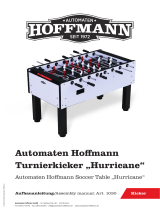 Automaten Hoffmann Hurricane Assembly Manual
Automaten Hoffmann Hurricane Assembly Manual
-
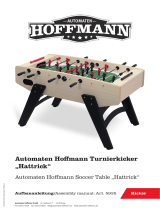 Automaten Hoffmann Hattrick Assembly Manual
Automaten Hoffmann Hattrick Assembly Manual
-
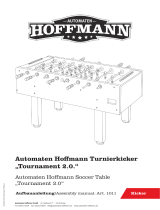 Automaten Hoffmann Kicker Tournament 2.0 Assembly Manual
Automaten Hoffmann Kicker Tournament 2.0 Assembly Manual
-
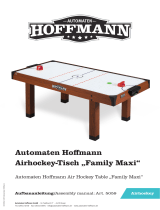 Automaten Hoffmann Family Maxi Assembly Manual
Automaten Hoffmann Family Maxi Assembly Manual
-
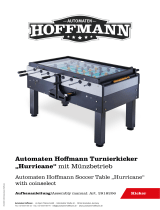 Automaten Hoffmann Hurricane Assembly Manual
Automaten Hoffmann Hurricane Assembly Manual
-
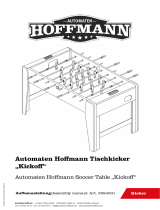 Automaten Hoffmann Kickoff Assembly Manual
Automaten Hoffmann Kickoff Assembly Manual
-
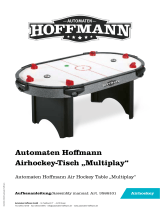 Automaten Hoffmann Multiplay Assembly Manual
Automaten Hoffmann Multiplay Assembly Manual
Andere Dokumente
-
Kicker Sportime Turnierkicker Guardian LED Benutzerhandbuch
-
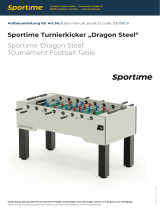 Sportime Country & Currency Settings "ST" Football Table Bedienungsanleitung
Sportime Country & Currency Settings "ST" Football Table Bedienungsanleitung
-
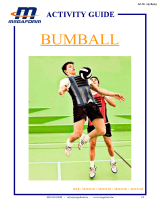 Spordas Wurfspiel "Bumball" Benutzerhandbuch
Spordas Wurfspiel "Bumball" Benutzerhandbuch
-
EXIT 101 0002 Benutzerhandbuch
-
EXIT 41.03.10.00 Benutzerhandbuch
-
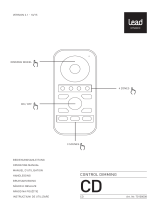 LEAD dynamic CD Bedienungsanleitung
LEAD dynamic CD Bedienungsanleitung
-
Haba 4286 Voetbaldinos Bedienungsanleitung
-
Haba 4268 Bedienungsanleitung
-
Haba 4206 Bedienungsanleitung















